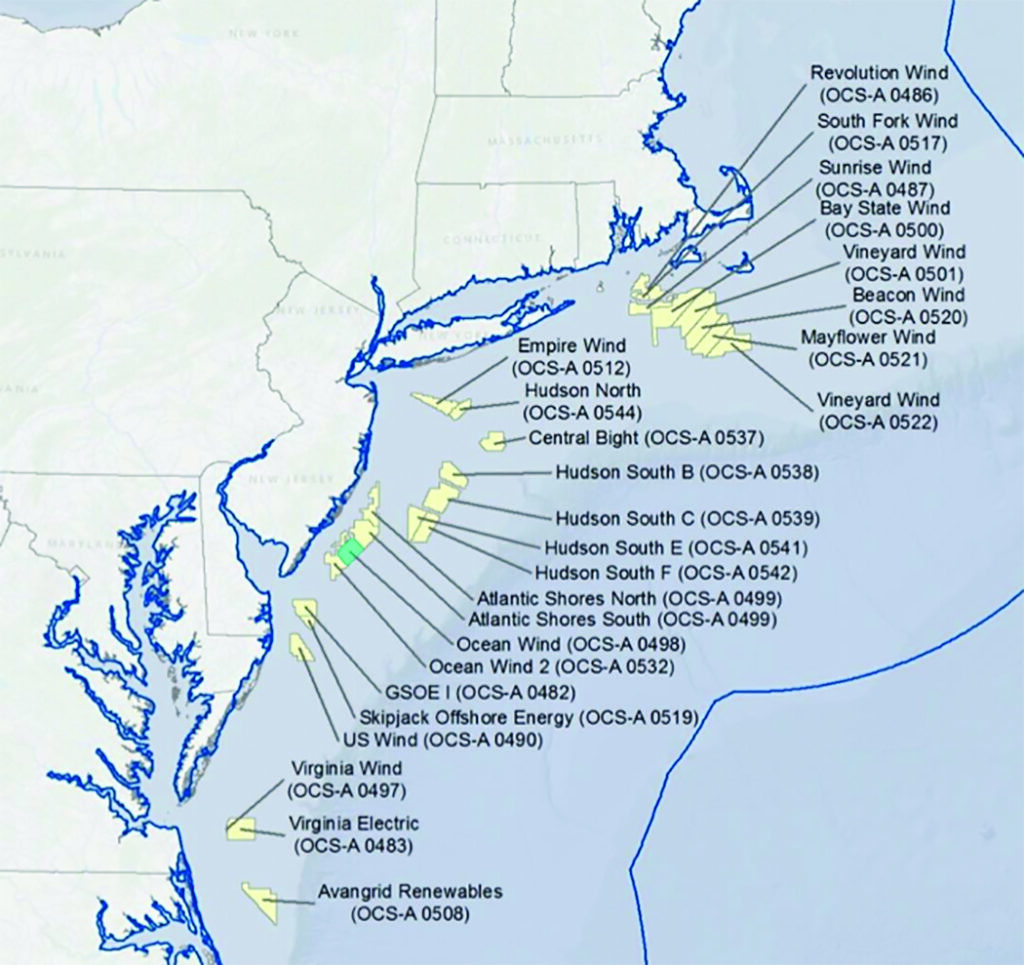More planned projects to bring wind farms as close as 8.8 miles from coast

OCEAN CITY — The Bureau of Ocean Energy Management’s Draft Environmental Impact Statement (DEIS) runs 1,400 pages. For those who search through it, there is a lot of information, some far beyond the proposal for Ocean Wind 1, the electricity-generating wind farm planned 15 miles off the coast of Cape May and Atlantic counties with as many as 98 towering turbines.
Nestled deep in the DEIS is a little, three-paragraph section, N.3.1.3.5, labeled “Ocean City Music Pier, Ocean City, New Jersey.”
It notes that looking out from the Music Pier at 811 Boardwalk — which is a popular Jersey shore spot for gazing at the ocean and south at the island’s beach and boardwalk — there may be something else on the horizon.
That something is as many as 612 wind turbines, some as close at 8.8 miles.
The DEIS report is about Ocean Wind 1, but it documents the myriad other proposed projects that would result in 1,370 wind-generating turbines up and down the coast, including the closest, Ocean Wind 2 and an Ocean Wind X.
The section includes other locations of “historic properties” as well as the Music Pier, one in Atlantic City and three in Ventnor City, saying that BOEM “has found the project would have an adverse visual effect” on them.
“The adverse effects on the viewshed of the above-ground historic properties would occupy the space for approximately 35 years, but they are unavoidable,” the report said, citing reasons listed in another section of the report.
Ocean Wind 1’s projected lifespan is 25 years, with the turbines being decommissioned and the towers removed after that, so the visual impacts listed in the report appear to include projects beginning after Ocean Wind 1 — and outliving it.
Barbara McCall, who owns property in Ocean City and vacations here, made note of that in her submission to BOEM during the public comment period on the DEIS.
She saw references to “Ocean Wind X,” a project that hasn’t been publicly announced. Ocean Wind 1 is under review and there is an Ocean Wind 2 proposed on a site adjacent to Ocean Wind 1. She said BOEM not only mentions an Ocean Wind X, but uses the document “to introduce all these other projects. If they’re introducing all these other projects, I think we need to be aware of them,” she said.
She saw Ocean Wind X outlined on a map, then found it in a section titled M-2 Cumulative Visual Simulations. “You saw it in that attachment over and over again. And on page 1,085, it lists Ocean Wind X and says it will be 9.0 miles to the Atlantic City Pier,” she said.
“I believe that a lot of people believe the closest wind turbine will be 15 miles off the coast. And that is incorrect. That is proven incorrect in a number of charts you see in the draft statement,” McCall said.
The DEIS does note that the adverse effect would not be so great as to disqualify the properties for inclusion on the National Register of Historic Places, but it does speak to concerns raised in Ocean City and other island resorts about the impact of wind farm projects on tourism and general property values because of the view of wind turbines.
The visual impact has been hotly debated, with project officials arguing the turbines would be small objects on the far horizon barely visible on all but clear days but opponents contending they would be an eyesore.
The turbines proposed in Ocean Wind 1, according to the DEIS, are on towers stretching about 512 feet above the surface of the ocean. The blades on the turbines have a radius of another 394 feet, putting the tips about 906 feet above mean low water sea level as they rotate.
In the DEIS, BOEM addresses the Ocean City Music Pier, a 1928 Mediterranean Revival-style building. The Music Pier has been an entertainment focal point of the boardwalk for nearly a century.
“Although the Project would not affect the building’s integrity of location, design, materials, and workmanship, it could affect its integrity of setting, feeling, and association. Therefore, a Potential for Adverse Effect finding was recommended,” the DEIS report states.
The adverse impact isn’t just from Ocean Wind 1, which has been the focus of BOEM public hearings and a public meeting last fall — coincidentally at the Music Pier — that drew a few hundred people to listen and comment on the project to representatives of the Danish company Ørsted and utility company PSEG, the entities behind Ocean Wind 1.
The DEIS includes information about all of the projects planned up and down the coast. That is why the visual impact includes a much greater potential from wind turbines (WTG) much closer than those planned 15 miles off the coast.
“The Ocean City Music Pier is 15.5 miles from the nearest WTG associated with the (Ocean Wind 1) Project and 8.8 miles from the nearest potential WTG location for other wind energy development activities,” the report states. “The total number of potentially visible turbines from Ocean City Music Pier is 612 WTGs. Of these, 98 theoretically visible WTGs (16 percent) would be from the proposed Project.”
That leaves more than 500 turbines from other projects.
In diagrams on visual impact, there is an Ocean Wind 2, mostly south of Ocean Wind 1 with 88 wind turbines, the closet 15.8 miles from shore and the farthest 30.7 miles away. There also is a project labeled Ocean Wind X that has 33 turbines, the closest of which would be 9 miles from shore. Other diagrams show some of those turbines in front of Ocean Wind 1 — or on the shore side.
Overall, the DEIS shows proposed wind turbine projects stretching from off the northern coastal tip of North Carolina to just south of Massachusetts. Off New Jersey alone there is Ocean Wind 1, Ocean Wind 2 — parts of which appear closer to the coast than Ocean Wind 1; Atlantic Shores South and Atlantic Shores North, which are closest to Atlantic and Ocean counties; a group farther off the coast, Hudson South B, South C, South E and South F; Central Bight and, off of northern New Jersey, Hudson North and Empire Wind. There are two proposals off Virginia, one off North Carolina and eight off the southern coast of Massachusetts.
The bigger Atlantic Shores South project includes 202 turbines as close as 11.2 miles from shore. Atlantic Shores North has 82 turbines no closer than 17.4 miles from the coastline.
New Jersey has a goal of 7,500 MW of renewable energy by 2035. If Ocean Wind 1 makes it through the permitting process, plans are for it to be operational in 2024, generating 1,110 megawatts of power to more than 500,000 New Jersey homes.
By DAVID NAHAN/Sentinel staff


